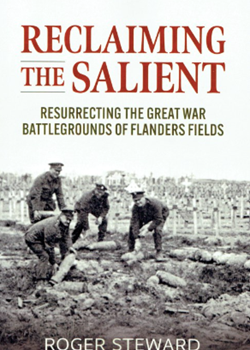Reclaiming the Salient: Resurrecting the Great War Battlegrounds of Flanders Fields
- Home
- World War I Book Reviews
- Reclaiming the Salient: Resurrecting the Great War Battlegrounds of Flanders Fields

By Roger Steward
£19.95 paperback: 240 pages, bibliography, index, photographs
ISBN: 978-115113-67-2
Helion, 2023
On any visit to the battlefield sites on the Western Front two features are unavoidable. Firstly, a countryside filled with cemeteries and secondly the large amount of munitions which are either stacked neatly by the road awaiting collection or simply lying in the fields. They are a reminder that the now bucolic scenery was a dreadful wasteland when the Great War ended in 1918. Roger Steward records and explains the clearance of the Flanders battlefields, which continues to this day.
Steward is a historian and battlefield guide who has lived in Ypres for over 10 years and well placed to give an account of the clearance of land littered with bodies and unexploded munition. The book sets out the vast scale of the problem that had to be dealt with. There were millions of items of unexploded munitions and over 500,000 men listed as missing on the Western Front. The introduction briefly describes the fighting on the salient which led to this. In Part One he describes the clearing of munitions from the battlefield and in the second part discusses the recovery and burial of the dead.
The British undertook the initial stages of clearing munitions but the need to demobilise its army meant that by October 1919 the Belgians had taken over. Clearance was dangerous but also big business and led to authorised and unauthorised activity. It continues to be dangerous, since 1992 it has claimed the lives of 100 military personnel. The professionalism and technical skills of the Belgians in disposing of increasingly unstable munitions shine through. Despite the dangers, some members of the public continue to handle unstable munitions, apparently overwhelmed by a desire to win a Darwin Award.
The second part starts with a BEF which in 1914 was unprepared for the recovery of bodies. It ends with today’s sophisticated work by the CWGC to recover and identify bodies. In between, Fabian Ware’s work to bring order from chaos to burials is described. Inevitably, at the end of the war the process of recovering the dead was haphazard. There were serious shortcomings in the early work, and it took time to establish a proper approach. This meant that in 1921, many bodies were still being found despite the formal completion of the search. The need to establish the right approach and the chaos of war made it impossible to have a totally effective way of recovering bodies.
It is difficult to fully comprehend the nature of the war today, as we travel through the countryside where it was fought. Thoroughly researched, this book not only works as a detailed case study but also as a wider discussion of the problems of clearing up after a war, unprecedented in its scale and violence. Reading this book will be of interest to those who want to better understand the nature and consequences of war.
Review by Tim Halstead





